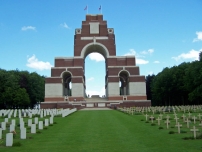| First Name: | Harry William | Last Name: | COLLINS | |
|---|---|---|---|---|
| Date of Death: | 17/02/1917 | Lived/Born In: | Highbury | |
| Rank: | Rifleman | Unit: | King's Royal Rifle Corps1 | |
| Memorial Site: | Thiepval Memorial, France | |||
Current Information:Born-Tottenham
The Somme trenches were no place to be during the winter of 1916-1917. Constant rain, snow and cold winds made them a nightmare. Men who were able to make the comparison said that the mud of the Somme was worse than that at Passchendaele, later in 1917. Simply surviving in the shell battered trenches was arduous enough but by now the plans for a major offensive at Arras were well advanced and they included a need to keep the Germans fully occupied on the Somme front. Starting early in the year, the British launched a number of attacks on the Somme front, aimed at capturing strategic points in the German line and thereby undermining their overall defences. One example of this was when, on 17th February, 1917, 2nd and 18th Divisions attacked towards Hill 130, south-east of Miraumont, while north of the River Ancre, 63rd Division made a subsidiary attack. Unfortunately the whole operation was undermined by two factors. The first was an overnight thaw that turned the frozen, hard ground to thick mud which clogged weapons and slowed down progress. The second was that somehow the Germans had got wind of the attack and at 4.30am they opened up a violent artillery bombardment along the whole front of the attack, resulting in serious casualties for the troops moving up for the attack. 2nd Division used 99 Brigade for this attack but first launched a subsidiary attack by 2nd South Staffordshire of 6 Brigade to uncover the right flank. 2nd South Staffordshire attacked Desire Support Trench and Guard Trench, south of the village of Pys, both of which were strongly defended. The artillery had not dealt effectively with the wire here and the few gaps created soon became targets for the German machine-guns. Despite this the objectives were reached in a number of places but counter-attacks soon forced 2nd South Staffordshire out with heavy casualties and at 9am the battalion was withdrawn. This failure was to have repercussions for the main attack. On 99 Brigade front, 1st King’s Royal Rifle Corps and 23rd Royal Fusiliers led the way with 22nd Royal Fusiliers forming a defensive flank and then joining the attack in the later stages. At first the attack went well. The first objective was gained, defensive flanks were established and counter-attacks seen off. They then headed for the second objective, the South Miraumont Trench, but because of the failure of 2nd South Staffordshire they were raked by machine-gun fire from the right. Some of 1st King’s Royal Rifle Corps managed to enter South Miraumont Trench but a fierce German counter-attack forced them back to the first objective. On their left the battalions of 18th Division faced the same problems and the attack came to a standstill. The final objectives had not been achieved but advances of of up to 1000 yards had been made. Boom Ravine had been taken but not Hill 103 and British casualties were high. 2nd Division alone had over 1,000 officers and men killed, wounded or missing. One of these was Harry Collins of 1st King’s Royal Rifle Corps. |
||||
| « Back to Search Results | ||||
| If you think any of the information shown here is incorrect, Click Here to submit your amends and comments | ||||




